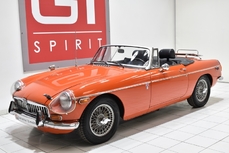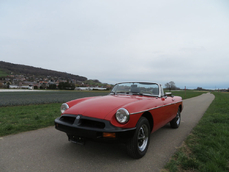MG MGB Roadster 1963
General description :
With the MGA of 1955, BMC finally shed MG’s antiquated image once and for all. The long-running T-Series served the marque incredibly well, and the cars helped create the foundation of the British sports car craze in America. However, by the 1950s, the TF was long in the tooth, and the quaint, prewar-inspired styling grew dated in the eyes of some buyers. With all-new, fully enveloped bodywork, and graceful, curvaceous form, the MGA arrived with much celebration. Power came from the new “B-Series” pushrod inline-four from BMC, and the MGA was an instant success, propelling MG into the next decade. Creating a successful follow-up to the MGA was bound to be a challenge, but designers felt buoyed by the momentum they created with the car, and their confidence reflects in the MGA’s replacement, which debuted in the second half of 1962.
Introduced in September of 1962, the MGB picked up where the MGA left off, and it turned out to be an even greater success than its predecessor. It had crisp, slab-sided styling that was simple, yet sophisticated, with an overall more upscale and modern appearance. Engineers employed unibody construction for the first time, with the live rear axle supported by leaf springs bolted to the shell, and a sub-frame supporting the independent front suspension. The arrangement was simple but highly effective, giving the MGB predictable handling that was more than a match for the 95 horsepower, 1.8-liter inline-four. While the B wasn’t notably faster than the A, it offered superior comfort, build quality, and high-speed handling. In the first full year of production, MG saw more than 30,000 cars sold, representing a whopping 75% increase in output over the MGA. The following year was even better, with nearly 40,000 cars built and the vast majority of them destined for export. Sales remained healthy for most of the MGB’s impressive eighteen-year production run. From May of 1962 through April 1965, the MGB had pull-style exterior door handles, which then changed to the more conventional pushbutton type. Enthusiasts consider pull-handle cars to be the purest form of the MGB roadster and count among the most desirable of the whole range. Over the years and through numerous variants, the MGB earned a place as one of the most iconic, widely cherished British roadsters of all time, with over a half-million produced, and a loyal following of passionate enthusiasts.
This 1963 MGB is a rare and desirable early “pull-handle” model from the first full year of production. This beautiful car is the recipient of an extensive, high-quality restoration finished attractively in black over a red interior. It has seen regular enjoyment and attentive maintenance in the hands of the most recent owner and remains a marvelous example. The black paintwork is smooth and glossy, with some minor polish marks in the finish and one small bubble noted near the beltline molding. Body fit is exemplary, and the panels are superbly straight and crisp, pointing to a very high-quality preparation. Doors open and shut with a precise feel, and panel gaps are tight and consistent. Bumpers, body side-moldings and exterior trim are in superb order, adding a bright pop against the black paint. Chrome knock-off wire wheels with black wall radial tires round out the beautiful presentation.
The MGB offered vastly improved interior accommodations over the MGA, with roll-up windows, roomy seats, and a considerably more modern feel overall. This car’s gorgeous red upholstery features black piping on the seats, with matching red carpets in factory-correct materials. A notable feature of early cars such as this is the body-color steel dash, housing an array of toggle switches and simple, easy to read Smiths instruments. Switchgear and controls all appear in excellent condition, including the heater controls which move smoothly and easily without binding. The factory-correct three-spoke banjo steering wheel and shift knob maintain the period-correct charm in the cockpit. Lastly, there is a newer black vinyl top in excellent condition, with a matching top boot to keep things neat and tidy.
The engine bay is superbly detailed, with correct hardware, labels, and detailing on the original, numbers-matching 1,798 cc four-cylinder. A chrome Coopers air cleaner feeds two SU carburetors, and a stainless steel exhaust system delivers an addictive and throaty note. Presentation under the bonnet is outstanding, with just some slight baking-off of the paint here and there from regular heat cycling.
Given the MGB’s long production run and cult-like popularity, it has long been one of the foundational cars of the car collecting and restoring hobby. Many enthusiasts cut their teeth working on MGBs, and a good many have amateur level refurbishments of varying degrees. This example, by contrast, has a superb, professional-quality restoration maintained in excellent condition by a dedicated collector. It is a marvelous example of the quintessential British roadster, gently mellowed and ready for fun on rallies, tours, and club-level concours events.
Offers welcome and trades considered
https://hymanltd.com/vehicles/6517
1963 MG MGB Roadster is listed sold on ClassicDigest in St. Louis by Mark Hyman for $36500.
Car Facts
Car type : Car Make : MG Model : MGB Model Version : Roadster Engine size : 0.0 Model Year : 1963 Sub type : Convertible Location : Missouri
Sold
Seller Information
Sold
People who viewed this MG MGB also viewed similar MG listed at ClassicDigest
Other cars listed for sale by this dealer
About MG
The MG (Morris Garages) story is a rich tapestry that spans several decades and involves various owners and corporate entities. Here is an overview of the MG story from its inception to the challenging period under the British Leyland (BL) corporation, highlighting key models and their specifications:1. Foundation and Early Years:
Year of Establishment: 1924
Founder: Cecil Kimber
Initial Focus: Coachbuilding and customization of Morris cars.
2. MG Octagon Logo:
The iconic MG octagon logo was introduced, representing the merger of MG with Morris.
3. MG M-Type Midget (1929–1932):
Key Features:
Compact two-seater.
Powered by a 0.8L engine.
The beginning of the Midget series.
4. MG T-Series (1936–1955):
Key Models:
MG TA, TB, TC, TD, TF
Key Features:
Roadsters with classic styling.
Success in motorsports, particularly in pre and post-World War II eras.
5. Post-War Era and MG A (1955–1962):
Key Features:
Departure from traditional styling.
First MG to feature a streamlined, modern design.
Available as a roadster or coupe.
Powered by a 1.5L engine.
6. MG B (1962–1980):
Key Features:
Classic British sports car design.
Available as a roadster or GT coupe.
Produced in high numbers.
Variants included the powerful MGC.
7. MG Midget (1961–1979):
Key Features:
Compact sports car based on the Austin-Healey Sprite.
Affordable and popular.
Various iterations with engine upgrades.
8. MG C (1967–1969):
Key Features:
A more powerful version of the MGB, featuring a 2.9L inline-six engine.
Limited production.
9. BL Corporation Era (1968–1980):
Acquisition by British Leyland (BL):
MG became part of the larger British Leyland corporation.
Struggles with quality control and labor disputes.
Decline in product quality and reputation.
10. MG MGB GT V8 (1973–1976):
Key Features:
Introduction of a factory-produced MGB with a V8 engine.
Attempt to inject performance into the lineup during challenging times.
11. MG RV8 (1992–1995):
Key Features:
Limited production convertible.
Revival attempt by Rover Group (successor to BL) to rekindle the classic MG spirit.
The MG story during the British Leyland era marked a challenging period with a decline in quality and reputation. However, the brand continued to be associated with classic British sports cars.











